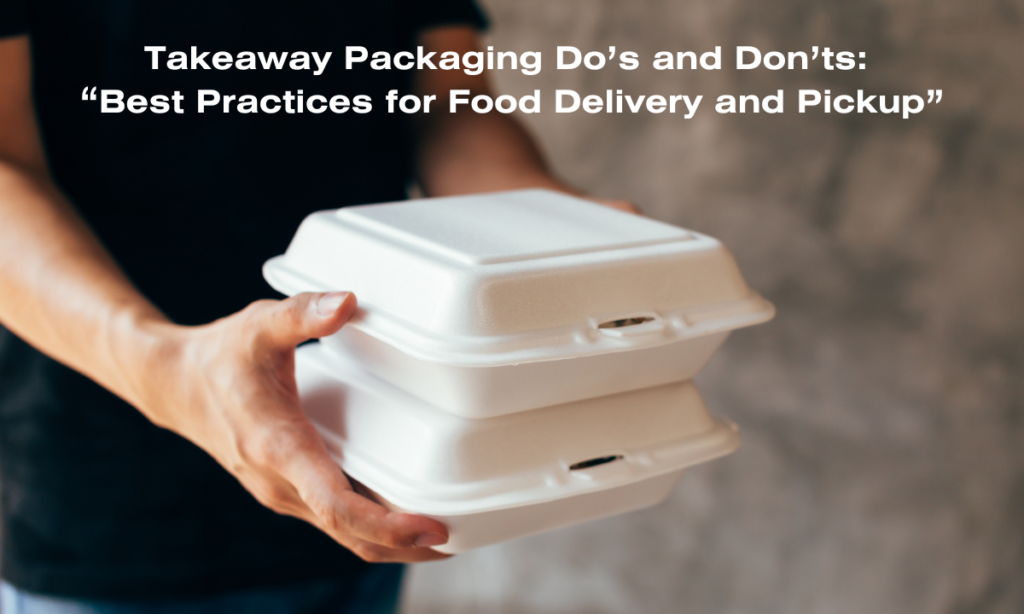In today’s fast-paced society, takeaway packaging serves as the bridge between food establishments and their customers. Whether it’s delivering a piping hot pizza or a refreshing salad, the right packaging ensures that food arrives safely and deliciously. However, achieving this requires adherence to certain dos and don’ts. In this guide, we’ll delve into the best practices for takeaway packaging in food delivery and pickup services, ensuring food remains fresh, safe, and delightful from kitchen to doorstep.
Selecting the Right Packaging Materials:
Choosing appropriate packaging materials is the cornerstone of effective takeaway packaging. Consider the following factors:
- Material Durability: Opt for materials that are sturdy enough to withstand transportation without compromising the integrity of the food inside. Materials like plastic, cardboard, and compostable options are popular choices.
- Food Safety: Ensure that selected materials meet food safety standards and are free from harmful chemicals or toxins. Look for labels indicating food-grade materials and compliance with relevant regulations.
- Environmental Impact: In an era of increasing eco-consciousness, consider eco-friendly packaging options such as biodegradable plastics or compostable materials. These choices not only reduce environmental harm but also resonate positively with environmentally-conscious consumers.
- Ensuring Proper Sealing and Closure: Proper sealing and closure are essential to prevent leaks, spills, and contamination during transit.
Here’s what to keep in mind:
Do’s : Best Practices for Food Delivery and Pickup
- Secure Seals: Utilize packaging with secure seals and closures to prevent any unintended opening during transportation. Tamper-evident seals provide an additional layer of security and reassure customers of the food’s safety.
- Leak Prevention: Invest in leak-proof containers and ensure lids fit snugly to prevent any liquids or sauces from leaking out. Double-check seals before handing over orders to delivery personnel or customers.
- Packaging Integrity: Regularly inspect the packaging for any signs of damage or wear. Damaged packaging compromises food safety and can lead to customer dissatisfaction.
Maintaining Temperature Control:
Maintaining optimal temperature control is crucial to preserve food quality and safety during transit. Consider the following strategies:
- Insulation: Use insulated packaging or thermal bags to keep hot foods hot and cold foods cold during delivery. Insulation helps to minimize temperature fluctuations and preserve the freshness of the food.
- Separation of Temperature: Pack hot and cold items separately to prevent temperature transfer and maintain the desired temperature of each item. This separation prevents hot foods from causing condensation or warming up cold items.
- Temperature Monitoring: Regularly monitor food temperatures throughout the delivery process. Use temperature monitoring devices or indicators to ensure that food remains within safe temperature ranges to prevent spoilage or foodborne illness.
Providing Clear Handling Instructions:
Clear and concise handling instructions are essential to guide customers on proper food handling and storage. Consider the following tips:
Reheating Instructions: Include clear instructions on how to reheat food safely, especially for items that may require reheating before consumption. Provide recommendations for microwave, oven, or stovetop reheating methods.
Storage Guidelines: Educate customers on proper storage practices to maintain food quality and safety. Provide guidance on refrigeration or freezing leftovers and the recommended storage duration for optimal freshness.
Disposal Instructions: Encourage eco-friendly practices by providing clear instructions on how to dispose of packaging materials responsibly. Include information on recycling options or composting for environmentally-conscious customers.
Emphasizing Food Safety Standards:
Maintaining rigorous food safety standards is non-negotiable when it comes to takeaway packaging. Consider the following protocols:
Staff Training: Train staff members on proper food handling and packaging procedures to ensure compliance with food safety regulations. Emphasize the importance of hygiene, sanitation, and proper handling techniques.
Quality Control: Implement quality control measures to inspect packaging integrity and ensure that only undamaged and sanitary containers are used for food storage and delivery.
Regulatory Compliance: Stay informed about local and national food safety regulations and ensure that takeaway packaging practices adhere to these standards. Regularly review and update protocols to reflect any changes in regulations or guidelines.
Don’ts:
Compromising on Quality:
- Avoid using low-quality or flimsy packaging materials that may fail to protect food or affect its quality.
- Steer clear of packaging options that contain harmful chemicals or toxins that could leach into food and pose health risks.
- Refrain from overfilling containers beyond their capacity, as this could lead to leaks, spills, and customer dissatisfaction.
Neglecting Food Safety Standards:
- Never compromise on food safety standards or regulations when selecting or handling takeaway packaging.
- Avoid using containers that are damaged, cracked, or contaminated, as they may compromise the safety and quality of food.
- Refrain from reusing disposable containers beyond their intended lifespan, as this could increase the risk of contamination and foodborne illness.
Conclusion:
In conclusion, takeaway packaging dos and don’ts are essential considerations for food establishments looking to provide a seamless and satisfying food delivery and pickup experience. By selecting the right packaging materials, ensuring proper sealing and closure, maintaining temperature control, providing clear handling instructions, and emphasizing food safety standards, businesses can uphold food quality, safety, and customer satisfaction. With a commitment to excellence in takeaway packaging, businesses can build trust, loyalty, and success in the competitive food service industry.
 (03) 8806 1672
(03) 8806 1672  sales@foodnpaks.com.au
sales@foodnpaks.com.au

Thank you for your sharing. I am worried that I lack creative ideas. It is your article that makes me full of hope. Thank you. But, I have a question, can you help me?
Your article helped me a lot, is there any more related content? Thanks!
I don’t think the title of your article matches the content lol. Just kidding, mainly because I had some doubts after reading the article.
Your article helped me a lot, is there any more related content? Thanks!
Your point of view caught my eye and was very interesting. Thanks. I have a question for you.